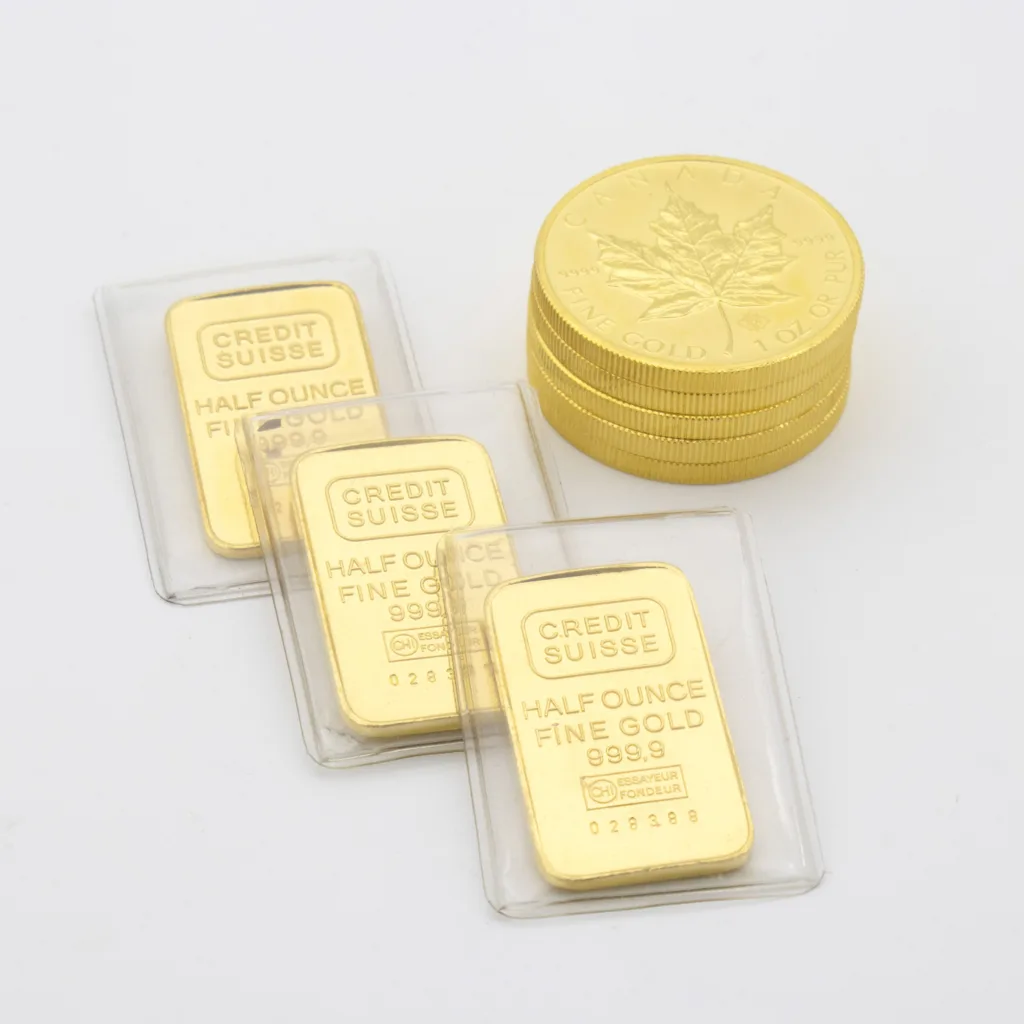Pure gold is a precious metal that has been revered throughout history for its beauty, rarity, and value. It is a soft, malleable metal that has a rich, yellow color and is highly sought after for use in jewelry, coins, and other decorative items.
The purity of gold is defined eithr in carats or fineness. A carat is 1/24 part of pure gold by weight, so 24-karat gold is pure gold. This means that 24 out of 24 parts of the metal are gold. In other words, it is 100% pure gold.
However, pure gold is too soft for most practical applications, which is why it is often alloyed with other metals to increase its strength and durability. The additional metals in the alloy also affect the color of the gold, resulting in different shades of yellow, white, and rose.
18-karat gold, for example, is 75% pure gold and 25% other metals such as zinc, copper, and nickel. This makes it harder and more durable than pure gold, while still maintaining a high level of purity. 14-karat gold is made up of 58.3% gold and 41.7% other metals, while 10-karat gold has roughly 41.7% pure gold.
Most often, 14-karat gold offers an ideal combination of depth of color, strong durability, and reasonable affordability. It is the most popular choice for gold jewelry in the United States, accounting for about 90% of gold jewelry sales.
The purity of gold is also measured in fineness, which is the number of parts per thousand of pure gold in the alloy. For example, 18-karat gold has a fineness of 750, meaning that it is 75% pure gold. Similarly, 14-karat gold has a fineness of 585, while 10-karat gold has a fineness of 417.
The purity of gold is measured in carats or fineness, with 24-karat gold being pure gold. However, pure gold is too soft for most practical applications and is often alloyed with other metals to increase its strength and durability. 14-karat gold is the most popular choice for gold jewelry in the United States due to its ideal combination of color, durability, and affordability.
Comparing 18K and 22K Gold
When it comes to choosing between 18K and 22K gold, it ultimately depends on personal preference and intended use.
18K gold is 75% pure gold and 25% other metals such as zinc, copper, and nickel. This additional metal content makes 18K gold more durable and harder than 22K gold, which is too soft for jewelry making. Therefore, if you’re looking for jewelry that can withstand daily wear and tear, 18K gold may be a btter option.
On the other hand, 22K gold is 91.6% pure gold and 8.4% other metals. This high gold content gives it a rich, yellow color and a softer, malleable texture. Due to its softness, 22K gold is a popular choice for intricate jewelry designs such as filigree or engraving.
It’s important to note that 22K gold is more prone to scratches and dents compared to 18K gold. However, it’s also worth mentioning that 22K gold is more valuable than 18K gold due to its higher gold content.
If you prioritize durability and strength, 18K gold is a better choice. However, if you prefer a softer texture and intricate designs, 22K gold may be the way to go.

The Meaning Behind the Term 24 Karat for Pure Gold
Pure gold is referred to as 24 karat, and this is because the karat system is used to measure the purity of gold. The karat system measures the amount of gold present in an object compared to other metals that may be included in the alloy. Pure gold is made up of 100% gold, whereas other gold alloys contain varying amounts of other metals.
In the karat system, 24 karat is 100% pure gold. This means that for eery 24 parts of the alloy, 24 parts are gold. The remaining parts are usually made up of other metals that are added to the gold to increase its durability and strength.
To determine the percentage of gold in an object, you can use the following formula:
(Number of karats / 24) x 100 = Percentage of gold
For example, if an object is 18 karats, the calculation would be:
(18 / 24) x 100 = 75% gold
This means that an 18 karat gold object is made up of 75% gold and 25% other metals.
It is important to note that the karat system is not the only way to measure the purity of gold. Fineness is another system used to measure the purity of gold, which is expressed as a decimal. For example, 24-karat gold is also considered 999 fineness, meaning it is 99.9% pure gold.
Pure gold is called 24 karat because it is 100% gold, and the karat system is used to measure the amount of gold present in an object compared to other metals.
The Benefits of 14K Gold
When it comes to choosing the perfect gold jewelry, one ofen comes across the term 14K gold. The question that arises is whether 14K gold is a good option or not. After all, investing in gold jewelry requires a considerable amount of money, and one must ensure that they are getting their money’s worth.
To answer the question, yes, 14K gold is an excellent choice for jewelry. Here’s why:
1. Durability: 14K gold is made by mixing 58.3% gold with other metals such as copper, silver, or nickel. This composition makes it more durable than 18K or 24K gold, which is softer and more prone to scratches and dents. This makes 14K gold perfect for everyday wear.
2. Affordability: Since 14K gold contains less pure gold than 18K or 24K gold, it is more affordable. This makes it a popular choice for those who want to invest in gold jewelry without breaking the bank.
3. Color: 14K gold is available in a range of colors, including yellow, white, and rose. It is often considered the best formulation for rose and white gold, as it offers a perfect balance of color and durability.
4. Depth of color: 14K gold has a rich and deep color that is not too bright or too dull. It is the perfect balance of color that gives gold jewelry its classic and timeless look.
5. Availability: 14K gold is widely available, making it easy to find and purchase. It is also the most popular choice for gold jewelry in the US.
14K gold is an excellent choice for those looking for durable, affordable, and beautiful gold jewelry. Its rich color, availability, and versatility make it a popular choice among consumers. When buying gold jewelry, it is essential to consider the type of gold and its composition to ensure that you are getting a quality piece that will last for years to come.
Comparing 10K Gold and 14K Gold
When it comes to determining whether 10K or 14K gold is better, it ultimately depends on what you’re looking for in a piece of jewelry.
First, let’s take a look at the difference in gold content between the two. 10K gold is made up of 41.7% pure gold, while 14K gold cotains 58.3% pure gold. This means that 14K gold has a higher percentage of pure gold, making it more valuable than 10K gold.
However, the lower percentage of gold in 10K gold has its advantages. 10K gold is more durable and less prone to bending, which is a definite perk if you plan on wearing your jewelry on a daily basis or if you have an active lifestyle. On the other hand, 14K gold may be more prone to bending due to its higher percentage of pure gold.
Another factor to consider is the color of the gold. 10K gold tends to have a slightly lighter color than 14K gold, which has a deeper, richer color. This may influence your decision depending on your personal preference.
In terms of cost, 10K gold is generally less expensive than 14K gold due to its lower percentage of pure gold. However, the price difference may not be significant enough to sway your decision one way or the other.
Ultimately, the decision between 10K and 14K gold comes down to personal preference and intended use. If you prioritize durability and don’t mind a slightly lighter color, 10K gold may be the better choice for you. If you want a higher percentage of pure gold and a deeper color, 14K gold may be the way to go.

Conclusion
Pure gold is a highly sought-after precious metal that has been valued for centuries. It is a symbol of wealth, status, and beauty. However, pure gold is not always the best option for jewelry and other decorative items. It is soft and malleable, which makes it prone to scratches, dents, and other forms of damage. That is why gold jewelry is often made with alloys that contain other metals such as copper, silver, and zinc. These alloys can enhance the durability, strength, and color of gold jewelry.
When buying gold jewelry, it is important to cnsider the purity of the gold, which is measured in karats. 24K gold is the purest form of gold, but it is also the softest and most expensive. 14K gold is the most popular choice in the US since it offers a good balance between purity, durability, and affordability.
Pure gold is a beautiful and valuable metal that has many applications in jewelry, art, and industry. By understanding the properties and characteristics of pure gold and its alloys, you can make informed decisions when buying and using gold products.
